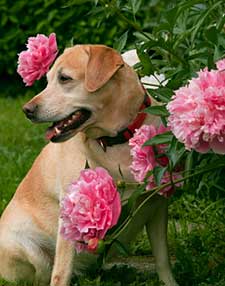You may well be concerned about pet-friendly garden design if you have a beloved dog or cat, so your pet can enjoy being out in the yard and garden too.
When planning your garden, remember: in a formal garden, anything askew sticks out, so, informal gardens lend themselves most easily to sharing with pets.
First, don’t forget creature comforts. Like you, your dog or cat will appreciate shade and a place to get a drink on a hot day. My dog, Toby, loves his outdoor water bowl, which I keep close to an outdoor faucet, so I can provide fresh water every day.
Ten tips for a pet-friendly garden design

Taking time to sniff out the peonies
1. Fencing: If you have a dog, your pet-friendly garden needs a solid fence. Four feet (1.2 metres) is high enough, but for some athletic dogs fences will need to be five or six feet (1.5-1.8 metres) high.
Gaps can be problematical, as curious dogs can wedge their heads between boards. Avoid large gaps between the fence and the ground for canine escape artists looking to dig their way out.
Does the entire yard need a fence or is a fenced dog run is adequate? (Fences, of course, won’t keep a cat in, unless you have a cat run that’s enclosed over the top.)
2. Paths: Like people, dogs and cats make a beeline to where they want to go. If your dog wears a dirt trail into the lawn, install a permanent path with pavers or stepping-stones. In small gardens, playful dogs can easily disturb paths of cedar mulch or pea gravel, so paths of brick or stone are easier to maintain.
3. Plants: When adding new plantings, larger-sized trees and shrubs and perennials are more likely earn pet respect than little sticks that look like chew toys. If you have sensitive plants or planting area just getting established, try a temporary chicken wire enclosure to keep pets out.
4. Mass planting: Massing shrubs or ornamental grasses can help keep pets on the straight and narrow. Most will go around rather than through such plantings. Grasses are particularly tough plants that are unlikely to be injured by the most rambunctious of dogs.
5. Soil: Try to avoid having bare soil – it’s a perfect invitation to cats and dogs to dig. Plant perennials close together, and choose tough pet-friendly plants – for example, use ground covers like thyme, cotoneaster, sweet woodruff or periwinkle between larger woody plants.
6. Mulch: Use inorganic mulch such as potato stones or pea gravel where appropriate. If you’re trying to get a new area of lawn to grow, sod is quicker to establish than seed, especially with pets using the yard.
7. Vegetable gardens: If you’ve planted vegetable seeds into the ground, keep the seed bed moist, as cats prefer to dig in dry, loose soil. Use straw mulch to cover the soil in between rows of vegetables or individual plants such as tomatoes. A permanent enclosure, such as an attractive picket fence is good idea for a herb or vegetable garden where you don’t want any dog or cat toilet activities to occur. Or you could try growing vegetables in containers.
8. Digging problems: The most pet-friendly garden solution here is to consider giving an unrepentant canine digger a fenced digging pit.
9. Dogs and lawns: Dog pee can be a problem. Here are some solutions. Provide cats with an outdoor litter box and outdoor scratching post.
10. Cat plants: Cats go wild for catnip (Nepeta catoria), rolling around on the plant and getting very playful. The plant’s precise effect on cats remains a mystery, but there is no question that cats adore it, as well as catmint (Nepeta faassenii and related species). Fortunately, both are tough plants that seem able to withstand feline attention. To discourage neighborhood cats, avoid growing these plants.
Related Information
Dogs and gardens – safety and training tips




